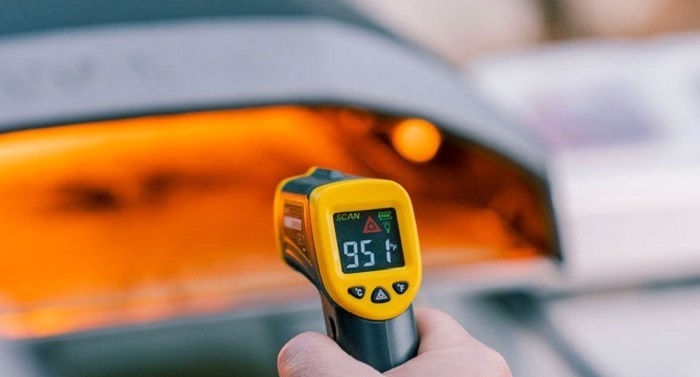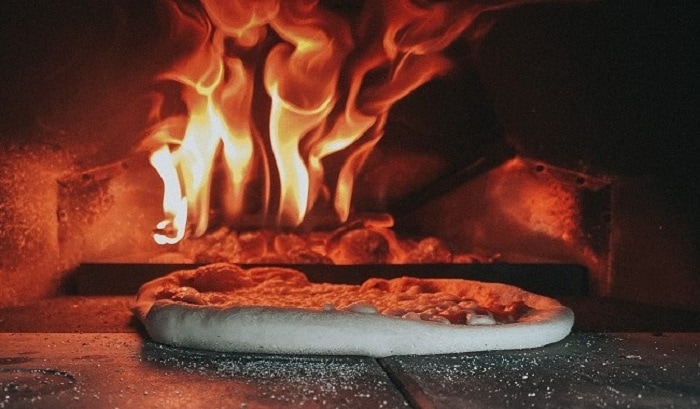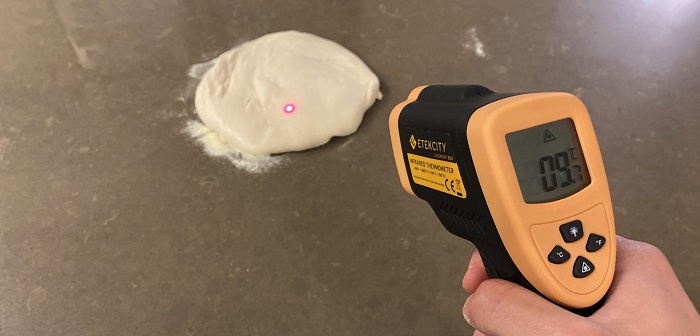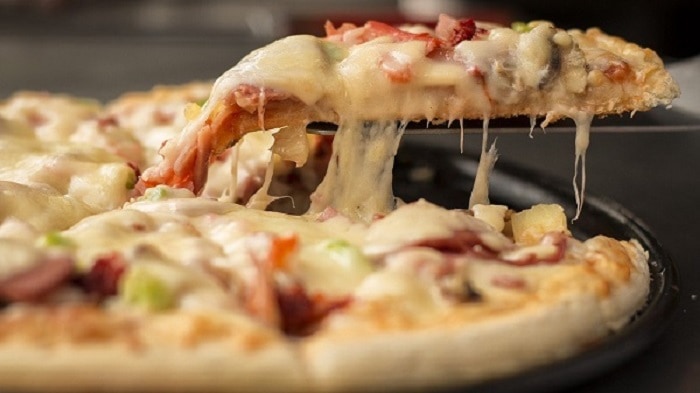Pizza Ovens Web participates in various affiliate programs, which means we may get paid commissions on certain products purchased through links in our blog.
7 Ways To Fix Undercooked Pizza Dough – The Ultimate Guide
I think that every person who makes pizza came across at least once with a pizza that came out undercooked.
If it happened to you too, you probably wonder – why did it happen? And is it fixable?
Well, the answer is absolutely yes! And in this article, I’m gonna show you the easiest ways to fix undercooked pizza.
Many reasons may have caused your pizza to come out undercooked, and I’ll be covering the most common reasons it might have happened and how to fix each one of them. (Including a tip from a pro).
Without further ado, here are the 7 most common reasons for undercooked pizza:
Table of Contents
1. pizza stone isn’t hot enough
I’m sure this one happened to most pizza oven owners:
Once I first got my Ooni Koda 16, I was extremely excited to use it – So I fired it up, waited about 15 minutes for the oven to heat up, and launched the pizza in.
After 2 minutes and a few rotations, the pizza looked ready on the top, so I took it out of the oven, sliced it, and gave it a shot.
And that’s when I noticed my pizza came out undercooked.
So why did that happen?
Many of us miss one really important step when using our pizza ovens:
Checking the stones’ temperature before launching in the pizza.
The stones’ temperature directly affects how your pizzas will come out –
- If it won’t be hot enough, you will get burnt cheese and an uncooked bottom.
- On the other hand, if it’s too hot, your bottom will burn quickly.

How to fix
The best solution to this problem is to check the temperature of your stone with an infrared thermometer.
It is a total game-changer.
In my case, after I started using one, I started having absolute control of the results coming out of my oven.
Pro-Tip
Generally, your stone should be around 400°C before you launch the pizza in. Although this step should help you get a better cook on the bottom of your pizza, the exact temperature depends on the type of pizza you are making.
We have a fully detailed guide about the best temperature for making each style of pizza, so make sure you check it out.
2. gas tank is running low
According to a research we made, the average pizza oven consumes about 0.43 kg of gas per hour.
That means that in theory, a 5 kg gas tank (12 lbs) should last for about 10 hours of use.
Unfortunately, that is far from what happens in most cases. Here is an example:
After a few uses of my pizza oven, I noticed that my stone was struggling to reach the right temperature and my pizzas came out undercooked.
The thing was, I could tell that the flame wasn’t high as usual, so I check the pressure inside the gas tank that the gauge showed, And saw it was running medium-low but still not empty.

So you are probably wondering, why was my flame not high as usual?
The reason is, that when your gas tank runs low, the pressure reduces, and less gas is floating into your oven.
How to fix
The easiest way to solve this problem is to get a pressure gauge to your propane tank, and fill it up when you see you are running low on gas.
Or if you aren’t interested in owning a gauge on your propane tank, just wait until you see the flame isn’t as it should be, and refill it.
Pro tip
5 kg propane tanks aren’t a good suit for fueling a pizza oven. They lose pressure fast, and you will need to refill them more frequently.
On the other hand, 12 kg propane tanks (~ 30 lbs) are a better suit for pizza ovens.
They don’t lose pressure as fast as the smaller-sized tanks do, and you will get a high flame until the tank runs out.
3. the flame is too high

This is probably one of the most common mistakes I see people do.
They heat up the oven at the highest setting, and when it’s ready to cook, they toss in the pizza and wait. Wrong move!
The highest flame is going to quickly burn the top of your pizza, while your bottom won’t have enough time to cook properly.
How to fix
Try following these few steps:
- In a gas pizza oven, make sure to lower the flame right before you launch the pizza in.
A stone that is at the right temp, and a medium-low flame should be a perfect combination to achieve an even cook.
- If you are using a wood oven, you will want to use your chimneys’ baffle to control the flame.
Once the baffle is fully opened, you get max airflow in your oven, which produces the highest flame.
To lower the flame, you need to close the baffle, which will reduce the airflow in your oven and lower the flame.
4. the dough is too cold

Using cold dough is also a common reason that pizzas come out undercooked.
Some people take the dough out after it rested in the fridge and use it right away.
When the dough is cold, it takes more time to cook from usually and what happens is that you will see your cheese and toppings are starting to burn while your dough is still not ready.
How to fix
If your dough is resting in the fridge, make sure you take it out at least 30 minutes- to one hour, before you want to use it. That should let the dough to get up to room temp as required.
5. your dough is too thick
Thick dough obviously takes more time to get cooked through.
If you toss your pizza in your oven at high temps, you will probably find out your toppings are ready, but the inside of your pizza is still raw.
How to fix
I found three methods that helped me overcome this problem:
The first one is to cook your pizza as you usually do, and when you see your cheese is almost ready, turn off the flame completely, and let the pizza cook for a few extra minutes while consistently checking on your bottom.
The second one is – to adjust the temperature depending on the pizza style you are making.
Because each type of pizza has a different thickness, each style has the right temperature it should be cooked at.
6. you are using too many toppings

Reason number 6 for undercooked pizzas is that you are using too much topping on your pizza.
When you stuff your pizza with lots of toppings, the dough absorbs less of the stone’s heat, which causes your dough to cook slower, and leads to undercooked pizza.
To fix that you’ll need to add less topping on your pizza, or add them after the pizza comes out of the oven (if possible).
7. you aren’t using your oven right
This one is for those who experience undercooked pizzas in their regular ovens.
When I first started making pizzas, I would bake them in my home oven, and it took me a while to discover the reason my pizzas came out undercooked.
How to fix
If you wish to bake Neapolitan style or just well-done pizzas in your home oven, you must change the way you are using your oven:
You’ll first need to cook your dough plane (with no toppings) for half the time.
Then take the pizza out, and just now add the sauce and cheese.
Now you are ready to finish the baking and you can put it back in the oven until you see the cheese is ready (starts to bubble).
When I started doing that, I achieved a balance between crispy well-done crust and perfect unburnt cheese.
Why you shouldn’t eat raw dough
Let me guess,
Your pizza just came out of the oven and you found out it is undercooked.
Now you are probably researching the web to find out if it is safe to eat.
Well, not only it isn’t safe for you to eat, but what If I tell you that you can fix it !

Most people won’t recommend eating undercooked food, and when it comes to pizza it is even more important to avoid.
Not only raw dough might be harder for your body to digest, if the yeast in the dough is still alive, the dough might continue rising in your digestive system, which will be a serious problem.
Bottom line is, avoid eating pizza if it’s undercooked. But, don’t throw it out as well.
I am gonna show you how you can fix it.
How To Fix – (PRO Tip)
Once I take out a pizza and find out it’s undercooked, I simply go back to my pizza or regular oven (doesn’t matter) and turn it completely off.
Then I put the pizza back in for a few more minutes so the stone will keep cooking through the pizza and it won’t burn on top by the flames.
The additional time the pizza will need depends on how hot your stone is at this point, and how crispy you would like your crust to be.
I personally like it on the crispy side, so after I let the oven cool down for a minute or two, I toss the pizza back in and give it another 2-4 minutes.
The first time I used that method in my Ooni Koda, resulted in one of my best pizzas, so make sure to give it a try.